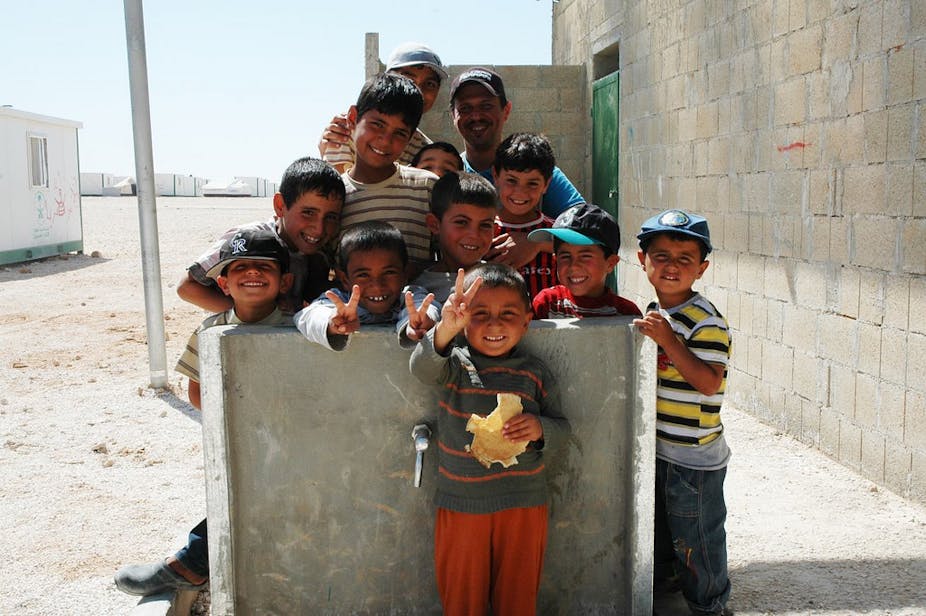A new city rises up in the Jordanian desert. Zaatari is now “home” – at last count – to 144,000 Syrians. The numbers are scarcely credible. One million child refugees; two million exiles in total; another four million internally displaced within Syria’s borders. Syria is emptying itself. The parallels that experienced aid workers draw are with some of the blackest moments in recent human history: Rwanda, Kosovo, Iraq.
I am writing this as the US Congress debates plans for punitive intervention, finessing “red lines” and weapon inspectors’ reports. Yet one thing is already clear. Whenever this fratricidal war is finally exhausted, there will still be a refugee crisis. For if exile begins in emergency, it does not end when that emergency is over. That is why, as overwhelming as the immediate needs of Syria’s refugees are, it is important not to lose sight of the longer-term challenges.
It’s easy to focus on how the Syria crisis is different, its scale unprecedented. However, it echoes many other displacements. Today, 15 million refugees and 29 million people are displaced worldwide. Three-quarters [of Afghans](http://www.internal-displacement.org/8025708F004CE90B/(httpCountries) affected by conflict have been displaced during their lives; in 2011 one-third of Somalis were displaced. Analysing these crises can help to understand why it’s the decisions the international community takes now that may frame Syrian displacement for decades to come.
Refugee crises need not become protracted. The short duration of the Kosovan refugee crisis is often forgotten: but in just 11 weeks between April and June, 300,000 not only fled from but then returned to Kosovo. In 1991, the Kurdish refugee crisis in Northern Iraq was resolved almost as quickly. Yet in both cases, the commitment required was decade-long international intervention and the results uncertain. There is small appetite for such projects in Syria.
No quick fix
The likelihood – given the increasingly sectarian and vicious nature of Syrian civil war – is therefore that there will be no swift resolution to either conflict or the refugee crisis. International law draws neat lines between civilians and combatants: but in civil wars, soldiers are sons, brothers, and fathers. Refugee camps are fertile recruiting grounds for extremist causes.

From Afghanistan to Rwanda to Sri Lanka, the dangers of blurring the lines between humanitarian space and insurgent forces are clear. One clear challenge in Syria is how to ensure the refugee camps remain apart from the conflict, while simultaneously acknowledging the close links between refugees and those fighting.
There is growing awareness among researchers that when displacement is protracted, lives can not just be fenced into the camp: mobility is crucial. Economic livelihoods and family communications often depend on moving back and forth across the border as war ebbs and flows. Helping refugees maintain links with their home communities also makes eventual return - if and when peace does arrive - far more likely.
Yet fear of protracted refugee crises has driven government policy in the opposite direction, towards exclusion and containment. Zaatari can only be understood in the long shadow of the 60-year old Palestinian refuge crisis. Along the Turkish border it’s the century-old Kurdish question that makes camps the compromise extracted for the border remaining open. Kenya and Pakistan are among the states who refuse to discuss local integration of their third-generation refugee populations, and continue to insist on encampment.
Such camps are intended to be temporary, emergency responses: but without peace, the refugees cannot “go home”. So over time, some de facto local integration is inevitable. This need not be a calamity: refugee networks can become development hubs. Dadaab camp in Kenya, home to half a million refugees, is estimated to make a annual net contribution of US$14m to the regional economy.

Need for long-term plan
The difficulty is that asking politicians and policymakers to plan for long-term exile requires explicit recognition that refugees are not just a temporary problem. For even if the Syrian war were to end tomorrow, there could be no instant return: the damage already done is enough.
Roads, public building, houses, power lines: all destroyed. There is overwhelming evidence from recent mass post-conflict repatriations to Afghanistan and South Sudan that premature returns are often not sustainable, and lead only to further waves of displacement.
This is not just about the crisis “over there”, aid to be paid for at a suitable distance from Western borders. If Syria shifts from emergency to entrenched crisis, industrialised states should not just be offering money, but also many more refugee resettlement places and opportunities for Syrian immigration - not least to demonstrate real solidarity with the Syrians’ regional hosts.
We should pray for swift resolution to Syria’s miseries: but we should also be pragmatic, and plan for protracted displacement. For this is the norm. Today, two-thirds of the world’s refugees spend five years or more in exile. Decades spent waiting in limbo are a second tragedy, a squandering of human capital that puts peace further out of reach. We may not be able to end the Syrian conflict: but in the meantime, we can and should lessen the poverties of exile.

